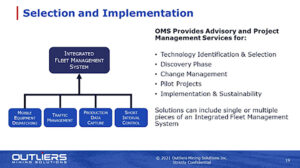Why install a Fleet Management System at your Underground Operation?
Fleet management systems, or FMS, have been a staple at open pit mining operations for decades. However, in underground mining operations, fleet management systems have been adopted much slower than their above-ground counterparts.
While smaller underground operations may have fewer ore draw points, resulting in less need for complex features such as dynamic dispatching. However, an FMS can still significantly benefit an underground operation.
Underground mine operations can take advantage of fleet management system technology in the following ways:
Production Data Capture
Many underground mining operations still rely on paper and pen to record production data. If information isn’t recorded accurately in the field, reporting data can be incorrect, leading to significant reconciliation at the end of the month. Removing the human factor from the process results in fewer errors and higher data accuracy, resulting in more effective decision-making. This data capture is especially important for in LHD and Truck payload data.
Maintenance Downtime Recording
Recording equipment downtime by utilizing a fleet management system improves accuracy and detail. By entering the downtime through an FMS’s onboard unit, there is no question of the accuracy surrounding the exact time equipment went down or when it returned to service. This method provides an accurate account of what went wrong and when, resulting in better future projections.
Operational Delays
One of the larger areas in which a mine may see performance gains when installing a fleet management system is transparent reporting of operational delays. Delays can be recurring and predictable, such as fueling or pre-shift inspections, or variables, such as traffic or the workplace not being adequately prepared. Accurate delay identification is a crucial component in improving operational efficiency.

What to Expect After Implementation of a Fleet Management System
Once a Fleet Management System has been implemented, you’re ready to see efficiency and performance gains immediately, right? Not so fast. Installation of the system is only the first step along your journey to enhanced productivity. The long-term value of an FMS requires an investment of training, time, and effort.
Setting goals and points of focus for your FMS are essential in identifying the types of data you’re looking for and how that data will be used to affect performance and efficiency.
You may want to ask the following questions:
- Who are my highest performers? What are they doing differently?
- How can I elevate operators who are not as productive?
- What are my major causes of mechanical downtime? Are they mainly linked to a single machine? A single operator?
- What are the largest delays I am seeing? What can I do to reduce them? Are there any that can be eliminated?
Once you have sufficient data, it’s time for the rubber to hit the road. Through analysis of the production, downtime, and delay data, you can see where your trends are and identify shortcomings that can be improved.
The Outliers Mining Solutions team has extensive experience working with Fleet Management Systems, including selection, implementation, and change management through conducting data analysis and supporting productivity improvement programs. OMS offers a suite of performance management tools to boost operational productivity at your mine site, including visual management programs, operational playbooks, and short-interval control.
If you are looking to get the most out of your fleet management system, or are considering an installation, Outliers Mining Solutions is well positioned to help you on your production improvement journey.
Connect with an Outlier
Subscribe to our monthly newsletter!
All Rights Reserved
